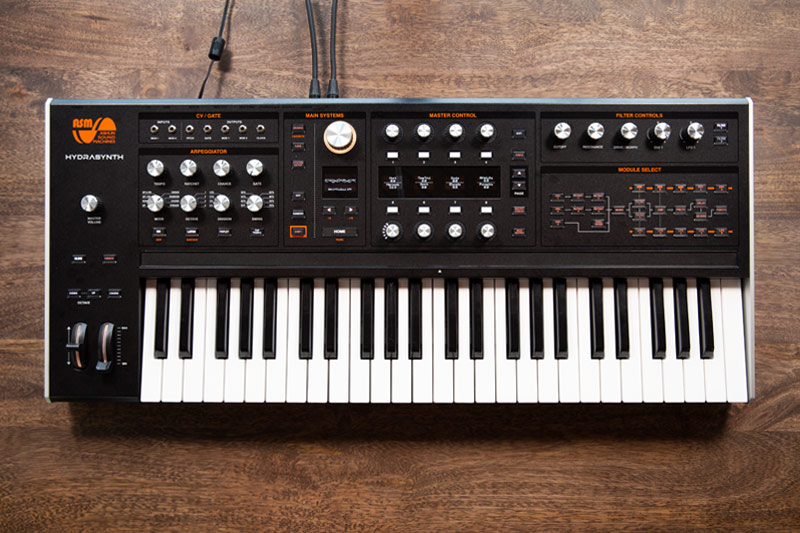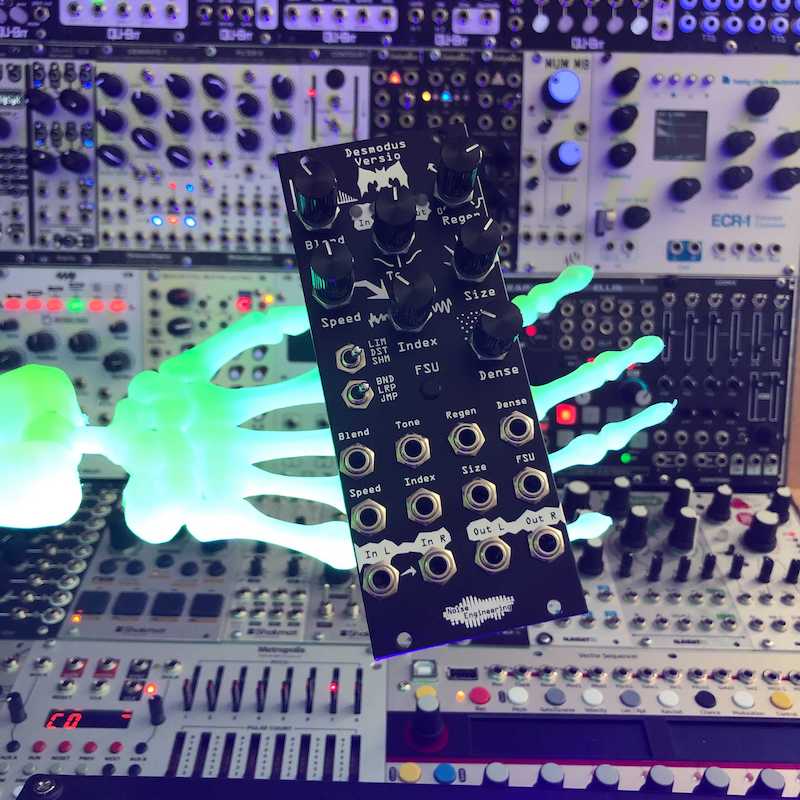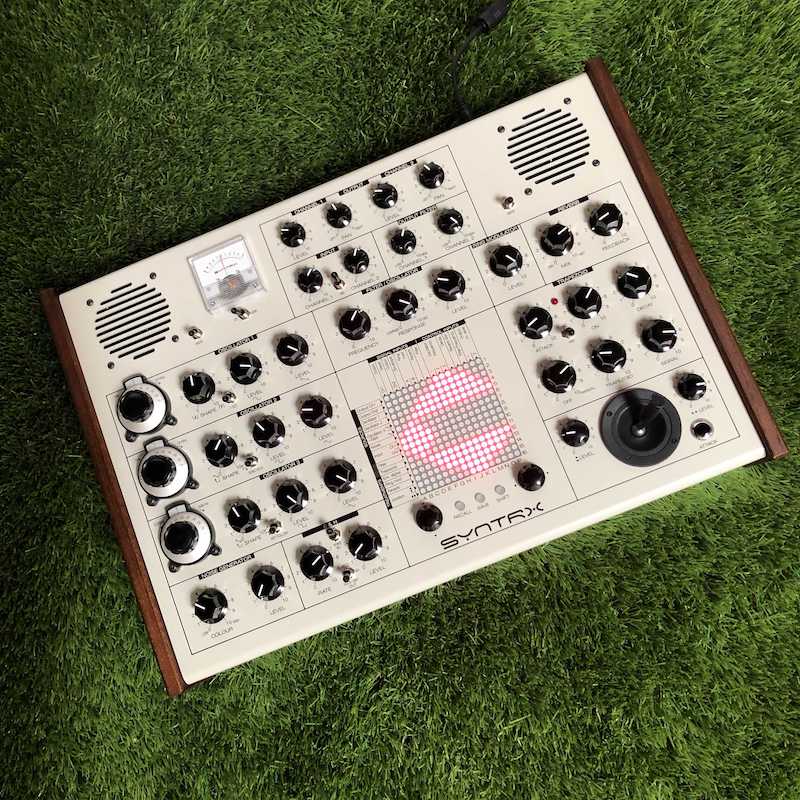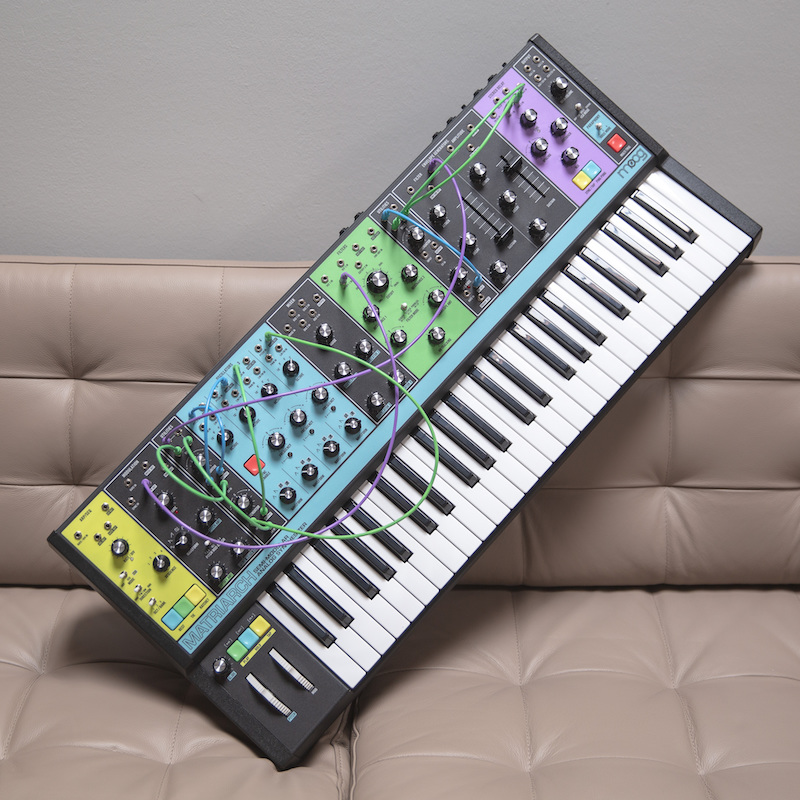With Halloween just around the corner, we've been thinking a lot about our favorite spooky sounds: classic horror soundtracks, Halloween sound effect cassettes, and VHS horror board games (ah man, did anyone else play Nightmare?), and more. Being synth enthusiasts, of course, we've also been having a blast messing around with some of our favorite synths in order to capture the spirit of the season.
And while there's no end to the number of ways you can create scary sounds—here are some of our favorite instruments and setups for creating howls, atmospheres, textures, and sound effects that will keep your neighbors wondering what sinister things you're up to.
ASM Hydrasynth
With a decidedly digital sound engine, ASM's Hydrasynth is a perfect choice for emulating the sounds of vintage '80s horror soundtracks. Though it can work beautifully as a virtual analog-style device, a lot of its magic comes from abusing the Mutants—internal oscillator modulation effects—and through extensive use of its 32-slot modulation matrix.

One of the Hydrasynth's harshest criticisms to date is that it is monotimbral. That is to say, that there is no option for creating keyboard splits that use multiple presets, and no provision for layering multiple presets on top of one another. This doesn't mean, however, that it's impossible to create layered sounds. One of my personal favorite tricks involves intentional modulation applied to the mixer section, which occurs after the oscillators and before the filter. The key to this technique is that the audio levels for each sound source in the mixer are available as modulation destinations in the mod matrix—meaning that you can use LFOs, envelopes, and various performance controls to alter the loudness of each oscillator relative to one another. And of course, with five envelopes and five LFOs per voice, this makes it easy to create distinct articulations for each oscillator—and with the potential provided by Wavescan and the Mutants (perhaps using FM, PWM, or the Wavestack modes in combination), each oscillator can sound much more dense and interesting than a single, static waveform.
Combined with the option to create sequence-like behaviors using the step LFOs and to trigger envelopes from LFOs means that you can effectively treat each "voice" on the Hydrasynth like a three-layer/tri-timbral synth, creating counterpoint between multiple voices and fading between sounds simply through the use of the modulation matrix. So while it might seem at first like the Hydrasynth isn't multitimbral, it can actually create quite dense, varied, layered sounds—and the press of a single key can be enough to set a Carpenter-esque sequence of sonic atmospheres into motion.
Noise Engineering Desmodus Versio
When Noise Engineering announced Desmodus Versio earlier this year, it was reasonable to assume that we could expect them to deliver a thoroughly untamed take on reverb. Indeed, this module won't be your typical source of plate, halls, or other traditional type of reverb. While you could approximate such sounds, DV excels at aggressive, in-your-face warping of whatever you patch into it. Plus, since Noise Engineering donates a portion of all of this module's sales to Bat Conservation International, and as bats are certainly among the spookiest of animals, we simply couldn't avoid talking about this module for our Halloween article this year.

But as with many things in modular, who says that you have to use a reverb as a reverb? Desmodus Versio is easily capable of being pushed into self-oscillation, turning it into a highly reactive sound source with its timbre and pitch shaped by the interaction of several parameters. This is further compounded when you start to incorporate feedback patching, something which is quite easy to do considering the module has stereo I/O. Feedback in general can offer an array of unpredictable results, and using reverb for this purpose is one of my favorite things to patch up. Subtle modulation alongside manual control will provide an ever-evolving drone, and at times devolve into noise or totally distort and break apart.
Desmodus Versio contains three different reverb modes: Limit, Distort, and Shimmer, and swapping between the modes will greatly impact the character of any feedback patch. I find the Shimmer mode in particular to be great for horrifying screams and anxiety-inducing rumbles. If you find your feedback patch growing stagnant, Desmodus Versio's FSU button injects noise into the feedback buffer for swiftly kicking things into motion again. Throwing a filter or additional effect in the loop further changes the sound between the output and going back into the input, and can result in totally otherworldly results ranging from dark and mysterious to strange and extraterrestrial—both equally fitting for Halloween!
Erica Synths SYNTRX
Erica Synths' newest instrument SYNTRX is a modern semi-modular synthesizer unlike any other. Inspired by the iconic EMS Synthi, SYNTRX is centered around a 16x16 I/O matrix that facilitates a clean cable-free patching experience. Don't be mistaken though, this synthesizer is not a clone of Synthi, but rather a completely original instrument with its own sonic flavor, quirks, and a workflow that rewards experimentation.

SYNTRX comprises three variable shape oscillators, a noise generator, a sample and hold module, a resonant filter that can act as a fourth sine wave oscillator, a ring modulator, a loopable trapezoid envelope generator with a built-in VCA, an analog spring reverb, input and output filters, joystick, and a pair of speakers for both listening and exploring feedback. The synthesizer also packs a generous amount of I/O, sporting two inputs switchable between line and microphone levels, two outputs, a dedicated headphone out, MIDI in and thru ports, as well as two CV inputs internally routed to the frequency parameters on oscillators 1 and 2, and a Gate input.
While all the modules in the SYNTRX are completely analog, the matrix itself is digital, and thus it allows for storing and recalling patches as presets. This adds an element of control, and predictability that is often missing in the world of analog modular synthesis. However, while the connections between modules can be saved and accessed at any point, the positions of the knobs and switches are not, and that creates a unique balance between control and chance. This ensures that every time the SYNTRX is turned on, the patch will likely sound slightly different (or significantly different if the knobs were moved a lot) than when it was last used.
This combination of modules and features establishes a very flexible framework for a wide variety of applications. Traditional subtractive synthesis patches are easily approachable, yet stranger and weirder sonic realms are always just around the corner. The latter part specifically makes SYNTRX a great choice for this Halloween-themed synth article. Not only does the synthesizer look like it was pulled out of a vintage sci-fi movie, but it can also be surely used to score one covering all the bases from outer space drones to voiceovers of alien creatures.
Try running a microphone into channel A of the Ring Modulator, and one of the oscillators into channel B, adjust the frequency of the oscillator to taste or even better modulate it with another signal, and your robot or alien voice is ready.
One of the easiest ways to generate some spooky sounds out of SYNTRX is to turn on the internal speakers and route the spring reverb through them. The reverb is very sensitive, and it is also capable of self-oscillating, thus at high-enough settings, even light vibrations around the instrument will provoke eerie feedback howls.
Koma Elektronik Field Kit
One of the most exciting things that happened to the electronic musical instruments market in recent years, at least for me personally, is that more and more odd and experimental instrument ideas are getting realized, and what's yet more important these strange instruments are met with excitement and anticipation from the public. Coincidentally, some of these instruments are capable of truly spooky noises. While there are many great pieces of gear out there that can create sounds to accompany a horror film or to scare your neighbors, today we are going to focus on Koma Elektronik's phenomenal Field Kit—a device that not only has its own unique sonic character but also benefits greatly of being interfaced with other instruments and the environment.
When Field Kit was originally introduced by Koma in 2017, it made an incredible amount of noise considering the experimental nature of its designs. Unlike many modern instruments that take inspiration from the recent history of popular, and dance music, the development of Field Kit was fed by the ideas of electronic music pioneers like Karlheinz Stockhausen, John Cage, Pauline Oliveros, and others.
Modular by design, Field Kit comprises several sections that can be combined to influence each other, incorporate other instruments, or random objects—including not necessarily musical ones. At the center, there is a four-channel mixer which can be used to amplify anything from contact and dynamic microphones to electromagnetic pickups, walkmans, or other instruments. To the bottom-left, you'll find a CV-controllable radio with a switch to select between AM, FM, and Short Wave. On the top-left of the Field Kit, there is a DC interface for driving motors and solenoids, with a handy CV/Trigger input. Next to it is an envelope follower, implemented to extract voltages and gates from audio signals. The bottom-right section of the instrument is occupied by the digital and analog sensor interfaces, allowing you to integrate your instrument even more closely with the surroundings. Finally, on the top-right, you'll find the instrument's three outputs: main, auxiliary, and a dedicated speaker output.
Koma Elektronik also released useful companion packs for Field Kit containing a variety of useful things to pair the instrument with ranging from contact mics to sensors. Additionally, the instrument comes with a handy tutorial book "50 Ways to Use Field Kit". But of course, don't feel limited by what is included in the packs and described in the book, as there are really countless ways the instrument can be used.
Now let's get back to our subject—Halloween and spooky sounds. In some ways, and I'm not afraid to put it this way, the Field Kit is the ultimate Halloween instrument. Firstly, it has its own sonic character with an unmistakable lo-fi charm. Connect a contact microphone to one of its channels, and attach it to something like a metal plate. Turn the volume, start moving your nails across the metal surface, and observe your neighbors running out of their doors. Secondly, explore the feedback by moving the microphone across the speaker. A good reverb pedal like EQD Afterneath will definitely be an aid. Third, connect a radio output to one of the mixer channels. Connect a proximity sensor to the analog sensor input, and connect its voltage output to the CV input of the radio. Connect the Field Kit to a speaker, and place it somewhere dark and creepy. Voila! Your Silent Hill-like monster detector is ready. Thirdly, experiment with the DC interface for yet more interactivity with physical objects. For example, secure a solenoid in front of the aforementioned metal plate, and use an IR sensor to detect motion and trigger that solenoid. Again, adding reverb here helps. Also, remember that Field Kit plays nicely with friends, and devices like Ether from Soma Laboratories, JMT's Noisy Microphone, and many others would be great companions.
These are just a few examples to get you started, but I hope it is clear to you now that Field Kit can be a valuable instrument for building your personal House of Horrors, as well as a great sound design tool in general.
Moog Matriarch
Recently revamped in an all-black look just in time for spooky season, Moog's Matriarch might be well known for delivering lush analog tones, but this semi-modular instrument has a dark side. Its unique architecture of being patchable while still providing the immediacy of a keyboard with paraphonic capabilities allows for some crafting of eerie textures and unsettling sounds.
A common trick dating back to the original Minimoog is to thicken up a lead or bass patch by ever-so-slightly detuning the oscillators from each other. When dialed in just right, the subtle differences in pitch result in a rich, chorus-like effect that adds a bit more dimension to the sound. Spread the oscillators further apart though, and our ears will start to discern distinct pitches beating against each other, often in an abrasive way until the harmonic spectrum of each notes line up in a consonant interval, like a perfect fifth or an octave. This kind of tuning (or lack thereof) may not be suitable for casual listening, but is sonically at home in experimental music and especially horror or generally creepy music or sound effects.

Thanks to its paraphonic modes, you can further push the technique above further into the territory of the unsettling. Traditionally dissonant intervals like the minor second and tritone can become even hairier than usual. I personally found the best results to come from the 2-voice mode, which pairs two oscillators together per note. Keeping each oscillator in a pair within a quarter step range or so affords you as much dissonance as possible—detune things too much and you may unintentionally end up with unisons or other consonant intervals.
The Matriarch's paraphony opens up some additional twists on modular synthesis techniques as well. One thing I do in many of my patches on any modular instrument is to use a multiple to split a signal going into a filter, then patching into the filter normally but also using this signal to modulate the cutoff frequency. In monophonic settings, this is a simple way to add a bit of edge to your patch without veering too far out of a tonal center, but really interesting things begin to happen when you apply this technique to a mix of sound sources rather than just a single oscillator.
I love taking the Mix output from the Matriarch and running it into the filter cutoff in the paraphonic modes, and the inclusion of mults and attenuverters on the instrument provides the option to apply inverse modulation between the left and right sides of the stereo lowpass filter. Apply any or all of these techniques in your next Matriarch patch (or with any other synth that offers oscillator fine tuning or VCO modulation of the filter), and you'll find a whole new realm of sinister tendencies waiting to be unleashed.
While this article features a handful of specific instruments, a lot of the techniques mentioned above can be applied to all kinds of synthesizers and effects processors. Take any of these ideas and use your own setup to really give your neighbors a fright as you conjure up dark spells and sonic seances this Halloween.












